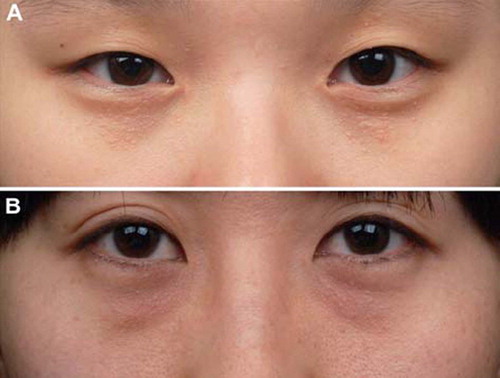Sirs,
A 22-year-old Korean woman presented with numerous asymptomatic skin-colored papules around the upper and lower eyelids that had been present for 3 years. She had no pertinent past medical or family history. The number of papules had increased over time but the patient had never been treated for the condition previously. Upon examination, multiple amber- or skin-colored papules ranging between 1 mm and 3 mm in diameter were visible on the upper and lower eyelids (). Upon histologic microscopy, the lesions presented as tadpole- or comma-shaped ductal structures enveloped by surrounding fibrous tissues, which were embedded deep within the dermis. After being diagnosed as syringoma, three sessions of combined carbon dioxide (CO2) laser (Model 40C, 40 WA; Sharplan Lasers Inc., Tel-Aviv, Israel) treatment and CO2 fractional laser (Mosaic eCO2™; Lutronic Corporation, Goyang, Korea) treatment were performed at 4-week intervals. Two months after the last combined laser treatment, the patient was satisfied with the results and complained of no major side effects.
Figure 1. (A) Multiple skin-colored discrete and confluent papules on the upper and lower eyelids diagnosed as syringomas. (B) Multiple skin-colored follicular papules on the lower eyelids diagnosed as sebaceous gland prominence of the eyelids.

A 28-year-old Korean woman presented with numerous asymptomatic skin-colored papules around the lower eyelids that had been present for 7 years. She had been intermittently treated for atopic dermatitis with topical steroid cream and systemic antihistamines since the age of 15 years. Otherwise, she had no pertinent past medical or family history. The number of papules had not increased over time and she had never been treated for the condition previously. Upon examination, multiple skin-colored follicular papules less than 1 mm in diameter were visible on the patient's lower eyelids (). The patient presented with dark circles under the eyes, which may have been allergic shiners associated with her past medical history of atopic dermatitis. No remarkable findings were observed on histopathologic examination and no evidence of syringomas was noted. After being diagnosed with sebaceous gland prominence of the eyelids, the patient was instructed to curb her habit of excessive eye rubbing.
Syringoma is a common benign skin tumor of eccrine origin that mainly appears in the periorbital areas, with a female predilection (Citation1). Clinically, they appear as multiple amber- or flesh-colored small discrete papules or plaque-type lesions ranging between 1 mm and 3 mm in diameter, as shown in the former patient (Citation1,Citation2). Upon histologic examination, syringomas are composed of tadpole- or comma-shaped ductal structures enveloped by surrounding fibrous tissues which are imbedded deep within the dermis (Citation1–4). Owing to their deep embedment within the dermis, complete removal is often unsuccessful and recurrence frequently takes place. Treatment of syringomas aims to destroy the dermal tumor using methods that include topical application of tretinoin cream, surgical excision, electrodesiccation, cryosurgery, and chemical peeling (Citation1–4). Laser therapies for the treatment of syringomas, such as temporary tattooing prior to Nd:YAG or alexandrite laser therapy, laser ablation, and CO2 laser treatments using the pinhole or drilling methods, have been reported as alternative methods (Citation1–4). Recently, our study group demonstrated the efficacy and safety of CO2 fractional laser treatment for syringomas (Citation5). However, complete removal of syringomas is often unsuccessful and recurrence occurs frequently as the lesions are deeply embedded within the dermis.
Clinical differentiation between syringomas and sebaceous gland prominence of the eyelids is necessary not only to make an exact diagnosis, but also to prevent overtreatment. Because most of the patients with syringomas or sebaceous gland prominence of the eyelids visit dermatology clinics with the purpose of cosmetic treatments, we experienced that the invasive diagnostic procedures, especially skin biopsies, were not always available. Moreover, the sebaceous gland prominence of the eyelids has not yet been fully emphasized as a differential diagnosis of syringomas.
Although the syringomas also can be shown as small discrete papules, they usually present as non-follicular lesions with irregular distribution on the upper and lower eyelids as well as periorbital areas. The sebaceous gland prominence of the eyelids characteristically appears as follicular-origin papules with even distribution, mainly on the lower eyelids. Patients’ medical histories suggesting the habit of excessive eye rubbing are also informative tips for diagnosis.
In the present report, we demonstrated the clinical photographs of the patients with syringomas and sebaceous gland prominence of the eyelids. We suggest that the differential diagnosis of syringomas should include the sebaceous gland prominence of the eyelids. However, more reports describing non-invasive diagnostic tips would seem to be necessary to help confirm the diagnosis of syringomas as well as to avoid overtreatment in patients with sebaceous gland prominence of the eyelids.
Declaration of interest: The authors report no conflicts of interest. The authors alone are responsible for the content and writing of the paper.
References
- Soler-Carrillo J, Estrach T, Mascaro JM. Eruptive syringoma: 27 new cases and review of the literature. J Eur Acad Dermatol Venereol. 2001;15:242–246.
- Cho SB, Lee SH, Lee SJ, Lee JE, Kim DH. Syringoma treated with pinhole method. J Eur Acad Dermatol Venereol. 2009;23:852–853.
- Sanchez TS, Dauden E, Casas AP, Garcia-Diez A. Eruptive pruritic syringomas: Treatment with topical atropine. J Am Acad Dermatol. 2001;44:148–149.
- Park HJ, Lee DY, Lee JH, Yang JM, Lee ES, Kim WS. The treatment of syringomas by CO2 laser using a multiple-drilling method. Dermatol Surg. 2007;33:310–313.
- Cho SB, Kim HJ, Noh S, Lee SJ, Kim YK, Lee JH. Treatment of syringoma using an ablative 10,600-nm carbon dioxide fractional laser: A prospective analysis of 35 patients. Dermatol Surg. 2011;37:433–438.
